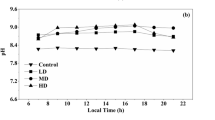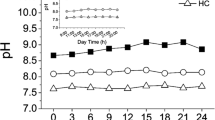Abstract
The amphipod Sunamphitoe namhaensis grazes on seedlings of Sargassum horneri in culture. To exterminate S. namhaensis, we immersed them in seawater with dissolved carbon dioxide—a treatment used previously to remove copepods in cultures of abalone and sea cucumber. Experiments were conducted under different CO2 (aq) concentrations and for different lengths of time. Amphipod mortality was 100% following immersion in CO2 seawater with a CO2 (aq) concentration of 26,262 µmol/kg (pH 5.0) for 60 min. When algal seedlings were immersed in CO2 seawater under these same conditions, their survival rate and growth were not affected.





Similar content being viewed by others
References
Achiha H, Ishimoto S, Suganuma M, Fuseya M (1995) Grazing the young thallus of “Nori” Porphyra spp. by Amphipoda. Mar Fouling 12:15–17 (in Japanese with English abstract)
Akamoku Aquaculture Technology Development Group (2017) Development of seedling production and aquaculture technologies for Sargassum horneri. Aquabiology Tokyo 39:400–407
Akimoto T, Matsui S, Nakamoto T, Hamada H (2010) Cultivation test of Sargassum horneri. Bull Fukuoka Fish Mar Technol Res Cent 20:67–72 (in Japanese)
Akizuki A, Tabata M, Kawamura Y (2007) Disinfectant effects of lactic acid on Pythium porphyrae as acid treatment agent. Suisanzoushoku 55:325–330 (in Japanese with English abstract)
Bierbower SM, Cooper RL (2010) The effects of acute carbon dioxide on behavior and physiology in Procambarus clarkii. J Exp Zool 313:484–497
Bierbower SM, Cooper RL (2013) The mechanistic action of carbon dioxide on a neural circuit and NMJ communication. J Exp Zool 319:340–354
Crawley KR, Hyndes GA, Ayvazian SG (2006) Influence of different volumes and types of detached macrophytes on fish community structure in surf zones of sandy beaches. Mar Ecol Prog Ser 307:233–246
Edgar GJ, Aoki M (1993) Resource limitation and fish predation: their importance to mobile epifauna associated with Japanese Sargassum. Oecologia 95:122–133
Fregin T, Bickmeyer U (2016) Electrophysiological investigation of different methods of anesthesia in lobster and crayfish. PLoS ONE 11(9):e0162894
Gunnill FC (1982) Macroalgae as habitat patch islands for Scutellidium lamellipes (Copepoda: Harpacticoida) and Ampithoe tea (Amphipoda: Gammaridae). Mar Biol 69:103–116
Holmlund MB, Peterson CH, Hay ME (1990) Does algal morphology affect amphipod susceptibility to fish predation? J Exp Mar Biol Ecol 139:65–83
Ikehara K (1987) Sargassum (Sargassum fulvellum and S. horneri) as a food in the coast of Japan Sea. Jpn J Phycol 35:233–234 (in Japanese)
Ishihi Y, Yokoyama H (2005) Food web structure in a sargassum bed based on stable isotope analysis. Kaiyo monthly 37:509–515 (in Japanese)
Ito R, Kamijyo Y (2012) Removal of sea anemone Boloceroides mcmurrichi adhered to cultivated Caulerpa lentillifera. Nippon Suisan Gakkaishi 78:439–443 (in Japanese with English abstract)
Katayama K (1982) On damage to cultivated Nori Porphyra caused by feeding of amphipods. Bull Fish Exp Sta Okayama Pref 139–141 (in Japanese)
Kawamura Y (1998) Basic manual of Nori produce in the pole system cultivation. Bull Saga Pref Ariake Fish Res Dev Cen 18:37–52 (in Japanese)
Kudaka J, Horii T, Izumi I, Kubo H, Shiwa T, Taira K, Nidaira M, Okano S, Kyan H, Tamanaha K (2011) Development of disinfection methods for Caulerpa lentillifera. Ann Rep Okinawa Pref Inst Health and Env 45:47–52 (in Japanese)
Lewis E, Wallace DWR (1998) Program developed for CO2 system calculations. ORNL/CDIAC-105. Carbon Dioxide Information Analysis Center, Oak Ridge National Laboratory. US Department of Energy, Oak Ridge, Tennessee
Maeda H, Hosokawa M, Sashima T, Funayama K, Miyashita K (2005) Fucoxanthin from edible seaweed, Undaria pinnatifida, shows antiobesity effect through UCP1 expression in white adipose tissues. Biochem Biophys Res Commun 332:392–397
Nakamuta H (2008) A novel method of eliminating copepods on attached diatoms collection plates during the artificial mass production of juvenile abalones. Saibai Giken 35:15–19 (in Japanese with English abstract)
Nishigaki T, Douke A (2014) Growth and maturation of two populations of Sargassum horneri (Sargassaceae, Phaeophyta) in western Wakasa Bay, the Sea of Japan. Bull Kyoto Inst Ocean Fish Sci 36:1–5 (in Japanese with English abstract)
Nishigaki T, Douke A (2016) Effect of acclimation and density on the germination rate of Sargassum horneri embryos stored at low temperature. Bull Kyoto Inst Ocean Fish Sci 38:19–20 (in Japanese)
Nishigaki T, Douke A, Wada Y (2007) Seedling production of edible brown seaweed, Sargassum fulvellum. Bull Kyoto Inst Ocean Fish Sci 29:13–16 (in Japanese with English abstract)
Nishigaki T, Yamamoto K, Endo H, Takeno K (2010) Growth and survivorship of Sargassum horneri (Sargassaceae, Phaeophyta) cultivated in Aso Bay, Sea of Japan. Bull Kyoto Inst Ocean Fish Sci 32:23–27 (in Japanese with English abstract)
Nishigaki T, Shinohara Y, Douke A (2016) Effect of water depth, time of planting and space between seedlings on growth, survival and yield of longline-cultured Sargassum horneri (Sargassaceae, Phaeophyta). Bull Kyoto Inst Ocean Fish Sci 38:7–12 (in Japanese with English abstract)
Noda H, Amano H, Arashima K, Hashimoto S, Nisizawa K (1989) Antitumour activity of polysaccharides and lipids from marine algae. Nippon Suisan Gakkaishi 55:1265–1271
Noguchi K, Noda S (2013) The development of a method for removing copepods by sea water aerated with carbon dioxide. Bull Saga Pref Genkai Fish Res Dev Cen 6:15–20 (in Japanese with English abstract)
Roberts DA, Poore AGB (2005) Habitat configuration affects colonisation of epifauna in a marine algal bed. Biol Conserv 127:18–26
Sakaguchi K, Park CS, Kakinuma M, Amano H (2001) Effects of varying temperature, salinity, and acidity in the treatment of Porphyra infected by red rot disease. Suisanzoushoku 49:77–83 (in Japanese with English abstract)
Schreider MJ, Glasby TM, Underwood AJ (2003) Effects of height on the shore and complexity of habitat on abundances of amphipods on rocky shores in New South Wales, Australia. J Exp Mar Biol Ecol 293:57–71
Seta T (2018) Germination rate of Sargassum horneri embryos stored at a low temperature in relation to developmental stage. Bull Kyoto Inst Ocean Fish Sci 40:1–4 (in Japanese with English abstract)
Stoner AW (1985) Penicillus capitatus: an algal island for macrocrustaceans. Mar Ecol Prog Ser 26:279–287
Sugiyama M, Tanaka Y (1982) Application of CO2 anesthetic method for the exfoliation of young abalones from collector. Bull Natl Res Inst Aquac 3:37–44 (in Japanese with English abstract)
Taguchi F, Fujiwara T, Yamada Y, Fujita K, Sugiyama M (2009) Alkalinity in coastal seas around Japan. Bull Coast Oceanogr 47:71–75 (in Japanese with English abstract)
Takeda T, Itazawa Y (1983) Possibility of applying anesthesia by carbon dioxide in the transportation of live fish. Nippon Suisan Gakkaishi 49:725–731 (in Japanese with English abstract)
Taniguchi C, Morita T, Kumon M, Douke A (2012) The effects of salinity on growth of the young plant Sargassum horneri. Bull Kyoto Inst Ocean Fish Sci 34:9–11 (in Japanese)
Yoshida T (1998) Marine algae of Japan. Uchida Roukakuho Tokyo 386–387 (in Japanese)
Yoshida G, Yoshikawa K, Terawaki T (2000) Germination rate and growth of Sargassum horneri embryos stored for a long term under low temperature. Nippon Suisan Gakkaishi 66:739–740 (in Japanese)
Acknowledgements
We would like to thank Dr. Atsushi Yamasaki and Dr. Toshiaki Miyajima (Fisheries Technology Department, Kyoto Prefectural Agriculture, Forestry and Fisheries Technology Center) for their various suggestions, Dr. Mitsuya Yamada (Fixed-term researcher of the Fisheries Technology Department, Kyoto Prefectural Agriculture, Forestry and Fisheries Technology Center) for helpful advice, and Steve O’Shea, PhD, from Edanz Group (https://en-author-services.edanzgroup.com/ac) for editing a draft of this manuscript. We are grateful to Dr. Tateki Fujiwara (Emeritus Professor of Kyoto University) for his advice on the calculation of inorganic carbon in water, and Dr. Hiroyuki Ariyama (Osaka Museum of Natural History) for the identification of the amphipod species.
Author information
Authors and Affiliations
Corresponding author
Additional information
Publisher's Note
Springer Nature remains neutral with regard to jurisdictional claims in published maps and institutional affiliations.
Rights and permissions
About this article
Cite this article
Seta, T., Kurashima, A. Exterminating Sunamphitoe namhaensis using carbon dioxide in seawater for culturing brown algae Sargassum horneri seedlings. Fish Sci 87, 365–370 (2021). https://doi.org/10.1007/s12562-021-01509-6
Received:
Accepted:
Published:
Issue Date:
DOI: https://doi.org/10.1007/s12562-021-01509-6




